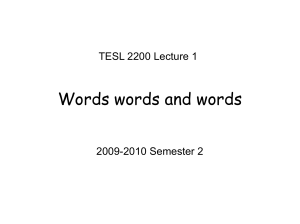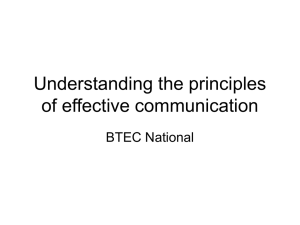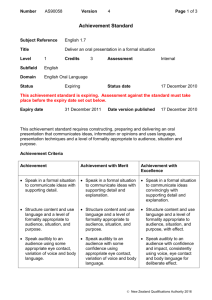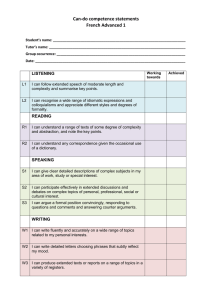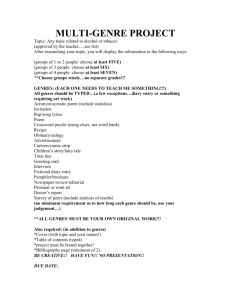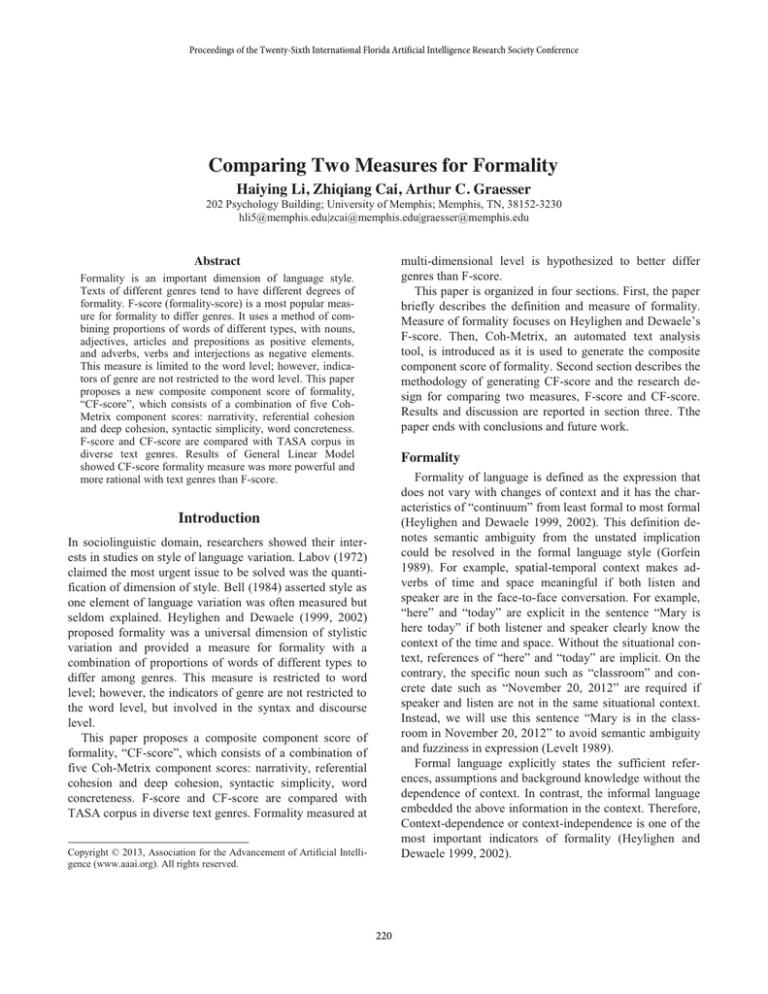
Proceedings of the Twenty-Sixth International Florida Artificial Intelligence Research Society Conference
Comparing Two Measures for Formality
Haiying Li, Zhiqiang Cai, Arthur C. Graesser
!"#
"$%&'($%&($%
Abstract
multi-dimensional level is hypothesized to better differ
genres than F-score.
This paper is organized in four sections. First, the paper
briefly describes the definition and measure of formality.
Measure of formality focuses on Heylighen and Dewaele’s
F-score. Then, Coh-Metrix, an automated text analysis
tool, is introduced as it is used to generate the composite
component score of formality. Second section describes the
methodology of generating CF-score and the research design for comparing two measures, F-score and CF-score.
Results and discussion are reported in section three. Tthe
paper ends with conclusions and future work.
Formality is an important dimension of language style.
Texts of different genres tend to have different degrees of
formality. F-score (formality-score) is a most popular measure for formality to differ genres. It uses a method of combining proportions of words of different types, with nouns,
adjectives, articles and prepositions as positive elements,
and adverbs, verbs and interjections as negative elements.
This measure is limited to the word level; however, indicators of genre are not restricted to the word level. This paper
proposes a new composite component score of formality,
“CF-score”, which consists of a combination of five CohMetrix component scores: narrativity, referential cohesion
and deep cohesion, syntactic simplicity, word concreteness.
F-score and CF-score are compared with TASA corpus in
diverse text genres. Results of General Linear Model
showed CF-score formality measure was more powerful and
more rational with text genres than F-score.
Formality
Formality of language is defined as the expression that
does not vary with changes of context and it has the characteristics of “continuum” from least formal to most formal
(Heylighen and Dewaele 1999, 2002). This definition denotes semantic ambiguity from the unstated implication
could be resolved in the formal language style (Gorfein
1989). For example, spatial-temporal context makes adverbs of time and space meaningful if both listen and
speaker are in the face-to-face conversation. For example,
“here” and “today” are explicit in the sentence “Mary is
here today” if both listener and speaker clearly know the
context of the time and space. Without the situational context, references of “here” and “today” are implicit. On the
contrary, the specific noun such as “classroom” and concrete date such as “November 20, 2012” are required if
speaker and listen are not in the same situational context.
Instead, we will use this sentence “Mary is in the classroom in November 20, 2012” to avoid semantic ambiguity
and fuzziness in expression (Levelt 1989).
Formal language explicitly states the sufficient references, assumptions and background knowledge without the
dependence of context. In contrast, the informal language
embedded the above information in the context. Therefore,
Context-dependence or context-independence is one of the
most important indicators of formality (Heylighen and
Dewaele 1999, 2002).
Introduction
In sociolinguistic domain, researchers showed their interests in studies on style of language variation. Labov (1972)
claimed the most urgent issue to be solved was the quantification of dimension of style. Bell (1984) asserted style as
one element of language variation was often measured but
seldom explained. Heylighen and Dewaele (1999, 2002)
proposed formality was a universal dimension of stylistic
variation and provided a measure for formality with a
combination of proportions of words of different types to
differ among genres. This measure is restricted to word
level; however, the indicators of genre are not restricted to
the word level, but involved in the syntax and discourse
level.
This paper proposes a composite component score of
formality, “CF-score”, which consists of a combination of
five Coh-Metrix component scores: narrativity, referential
cohesion and deep cohesion, syntactic simplicity, word
concreteness. F-score and CF-score are compared with
TASA corpus in diverse text genres. Formality measured at
/
3!5
(
5(
5(6#
<===%(((%
>%5%
220
The extent of shared context or common ground between speaker and listener during the conversation determines the choice of type of discourse during communication (Clark and Marshall 1981). If speaker and listener
share more background, it is easier for them to understand
referred expressions with less effort (Krauss and Weinheimer 1966). Consequently, they tend to use less formal language dependent on their shared context (Heylighen and
Dewaele 1999, 2002). If they do not have more shared
common ground, they tend to choose more formal language independent on the context to avoid ambiguity and
fuzziness (Biber 1988; Clark and Brennan 1991; Heylighen
and Dewaele 1999, 2002).
The next section introduces the measure of formality in
previous research.
of flexibility, directness, implicitness, involvement and less
information. These features are indicated by pronouns,
verbs, adverbs and interjections. Thus, they provided a
measure for formality with the formula below:
F = (noun frequency + adjective freq. + preposition freq.
+ article freq. – pronoun freq. – verb freq. – adverb
freq. – interjection freq. + 100)/2.
This measure of formality is called as “F-score”. “Fscore” refers to formality score within the range from 0 to
100 in percentage. The higher F-score, the more formal the
text tends to be. F-score is recently used to evaluate the
concept of formality at the sentence level with the human
judgment (Lahiri, Mitra, and Lu 2011). Teddiman (2009),
however, found F-score failed to distinct formality of
online diary entries from online diary comments. Thus, a
more effective measure for formality is put on the agenda
to satisfy the fine-genre analysis.
The goal of the current paper is to develop a composite
component score to measure formality extending from
coarse word categories to fine-grained categories, and from
lexical level to syntactic, semantic and discourse level with
automated text analysis tool, Coh-Metrix.
Measure for Formality
A lot of studies on the quantification of formality have attempted to use linguistic features. These linguistic
measures included proportion of explicitness versus implicitness (Hasan 1984; Leckie-Tarry 1995), lexical density
to differ written texts from spoken (Halliday 1985), nouniness in politeness speeches (Brown and Levinson 1979),
and the ratios between the amount of nouns and verbs,
nouns and pronouns, and the parts of speech related to the
nominal like nouns, adjectives and articles, and the verbal
like auxiliary verbs and adverbs (Fielding and Fraser
1978). Even though the researcher proposed these theories,
they did not evaluate the theories with empirical studies.
Biber (1988) used 67 linguistic features to differ spoken
and written texts with the method of factor analysis. The
extracted six factors include involved versus informational
production, narrative versus non-narrative concerns, explicit versus situation-dependent reference, overt expression of persuasion, abstract versus non-abstract information, on-line informational elaboration. Even though this
multi-dimensional analysis provides a much clearer variation across speech and writing, this method could not distinguish all genres significantly. In addition, six underlying
factors representing linguistic features seem too much for
some researchers. Therefore, one combination of dimension is required to represent the style of language of variation to differ genres.
Heylighen and Dewaele (1999, 2002) proposed formality as a universal dimension of stylistic variation. They
claimed there were two types of formality: surface formality and deep formality according to the extent of required
attention to form for the sake of convention or for the sake
of accurate interpretation. The formal style of language has
the features of detachment, accuracy, rigidity, cognitive
load, and dense information. These features are represented
by high proportions of nouns, adjectives, prepositions and
articles in texts. In contrast, informal style has the features
Coh-Metrix
Coh-Metrix was developed to analyze texts on multiple
linguistic features with indices at levels of words, syntax,
the explicit text base, the situation model, and the discourse genre and rhetorical structure (Graesser, McNamara, Louwerse, and Cai 2004; McNamar, Graesser and Kulikowich 2011). Modules of Coh-Metrix use lexicons, partof-speech classifiers, syntactic parsers, templates, corpora,
latent semantic analysis and other components, which are
widely used in computational linguistics.
Coh-Metrix includes hundreds of indices related to
readability or text difficulty, cohesion and language, 53 indices among which were evaluated and used to perform the
Principal Components Analysis (PCA). Table 1 showed the
linguistic indices in each dimension with primary loading
greater than .35. The orthogonal varimax rotation extracted
eight components in terms of Eigen value greater than 1.
The first five components were labeled as narrativity, syntactic simplicity, word concreteness, referential cohesion
and deep cohesion according to the underlying linguistic
features in each dimension. The rest three components including no more than three indices were not considered in
this study.
Narrativity refers to texts that are story-like or informational with linguistic features such as nouns, adjectives,
verbs, pronouns and adverbs etc. Part of these linguistic
features was used by F-score, which treated nouns and adjectives as positive elements, and verbs, adverbs and pronouns as negative elements. However, if more linguistic
features such as syntactic structure ease and cohesion were
221
included, the word type features are mutually represented
in one underlying feature “Narrativity.”
Therefore, Coh-Metrix makes it possible for us to obtain
five comprehensive dimensional scores which will be used
to compute CF-score at the multi-textual level. Meanwhile,
Coh-Metrix also provides the indices of all the word types
which will be used to compute F-score.
The goal of this paper is to test which measure of formality could better predict text genres, F-score or CFscore.
Dimension Label
Description
Narrativity DENPRPi
Pronoun
NOUNi
Noun
SYNNP
Number of modifiers per noun phrase
READASW Word length, number of syllables
FRCLacwm CELEX content word frequency
VERBi
Verb
PRO3i
Third person pronoun
FRCLaewm CELEX Log frequency for all words
WRDAacwm Age of acquisition for content words
ADJi
Adjective
WRDFacwm Familiarity for content words
PRO1i
First person pronoun
FRCLmcsm CELEX Log minimum for content words
ADVi
Adverb
DENNEGi Negation density
MEDwtm
Minimal Edit Distance, part of speech
AGLSPSVi Agentless passive voice density
Referential CRFPC1um Content word overlap, adjacent sentences
Cohesion CRFPCaum Content word overlap, all sentences
CRFBA1um Argument overlap, adjacent sentences
CRFBAaum Argument overlap, adjacent sentences
MEDawm Minimal Edit Distance, all words
LEXDIVVD Lexical diversity, VOCD, all words
LEXDIVTD Lexical diversity, MTLD, all words
CRFBN1um Noun overlap, adjacent sentences, binary
TYPTOKc Type-token ratio, content word lemmas
LSAGN
LSA given/new, sentences
CRFBSaum Noun overlap, all sentences, binary
LSAassa
LSA overlap, adjacent sentences
LSApssa
LSA overlap, all sentences in paragraph
Syntactic READASL Sentence length, number of words
Simplicity CAUSV
Causal verb
STRUTt
Sentence syntax similarity, across paragraphs
INTEi
Intentional verbs incidence
LexDensity Lexical diversity
SYNLE
Left embeddedness, words before main verb
Word Con- WRDIacwm Imagability for content words
creteness WRDCacwm Concreteness for content words
WRDMacwmColorado norms, content words
Deep Cohe- CONCAUSi Sentence syntax similarity, paragraphs
sion
CONLOGi Logical connectives
CONi
All connectives
CONTEMPi Temporal connectives
INTEC
Ratio, intentional particles to intentional verbs
CAUSC
Ratio, casual particles to causal verbs
Method
Corpus
TASA corpus (The Touchstone Applied Science Associates, Inc., http://nora.hd.uib.no/corpora/2004-1/0322.html)
is used in this study. TASA corpus includes academic textbooks for students from kindergarten to the first year of
college in the United States (Zeno et al 1995). The TASA
corpus has nine text genres consisting of 119,627 paragraphs taken from 37,651 samples with 10,829,757 words
(See Table 2). The majority of genre is language arts
(42.62%), followed by social studies (27.82%) and science
(14.26%). Other genres such as business, health, miscellaneous, home economics are minority of genres, not exceeding 4%. There is an unknown genre (5.88%) in this corpus.
We, therefore, used TASA in this paper because it is a
large corpus with miscellaneous fined text genres and has
proven to be able to represent other texts and differences
between text genres.
Genre
N
Business
Health
Home Economy
Industrial Arts
Language Arts
Miscellaneous
Science
Social Studies
Unknown
Total
1079
1359
283
142
16044
675
5356
10501
2212
37651
Word Count
Mean
SD
302.17
19.80
279.18
20.46
269.29
20.33
278.49
23.63
285.94
24.59
293.95
21.64
283.96
22.99
292.91
24.75
282.93
24.41
287.64
24.56
WPS
Mean
SD
18.58
4.64
14.99
5.64
20.47
4.58
16.29
3.17
17.49
10.10
19.92
8.45
15.61
6.17
20.01
8.96
18.62
5.17
17.99
8.87
Table 2: Descriptive statistics of words per sentence and number
of cases in each genre.
Table 2: Linguistic indices in each dimension with loading greater than .35.
Note: WPS = Word per sentence.
Referential cohesion was denoted by explicit arguments
and ideas that overlapped across all sentences or within adjacent sentences. Linguistic feature in this dimension included noun overlap, argument overlap, content word overlap, lexical density, and latent sematic analysis, etc. Similarly, deep cohesion was indicated by the connectives that
link sentences or clauses such as causal, intentional, spatial
or temporal connectives from the perspective view of the
deeper semantic level.
Syntactic simplicity, the level of difficulty of sentences,
was designated by sentence length, causal verbs, sentence
syntax similarity, etc. The higher scores indicated the sentence had fewer words and simpler syntactic structure.
Word concreteness was signified by content words related
to concreteness and imagability.
Procedure
Coh-Metrix is used to analyze TASA corpus and obtain the
individual indices of linguistic features and the five dimension scores.
To compute F-score, the following word types are needed: nouns, adjectives, prepositions, articles as positive elements, pronouns, verbs, adverbs, and interjections as negative elements. These indices are computed in permillage.
Thus, percentage is first computed for these eight word
categories. Then F-score is computed according to formality formula proposed by Heylighen and Dewaele (1999):
222
F = (noun frequency + adjective freq. + preposition freq. +
article freq. – pronoun freq. – verb freq. – adverb freq. interjection freq. + 100)/2.
F-score is a value within the range from 0% to 100%.
A combination of formality score is computed with the
combination of the five-dimension scores with the formula
below:
CF-score = (referential cohesion + deep cohesion – narrativity – syntactic simplicity – word concreteness)/5.
Dimension scores are standardized scores. CF-score, therefore, is a standardized score with “0” as the mean, above
“0” representing more formal, below “0” representing less
formal.
To compare F-score and CF-score, percentage of Fscore is converted into Z score in order to make F-score
have the same value unit as CF-score with the formula below:
z = (x - μ)/s (Marx and Larsen, 2006)
among which, z is the standardized score we want, x is the
observation value, μ is the population mean, and s is the
standard deviation of the population.
Based on this formula, F-score is computed:
F-scoreZ = (F-score - 49.2112)/6.01559
In this formula, 49.2112 is the mean of F-score in all the
cases in TASA corpus; and 6.01559 is the standard deviation. F-score represents the value of each observation.
Thus, we converted percentage F-score to Z F-score, which
is labeled as F-scoreZ (We still use F-score instead of FscoreZ to represent measure for formality proposed by
Heylighen and Dewaele for convenience).
ble 3). The effect size is .237. Tukey’s post-hoc comparisons (Kirk 1982) of nine genres indicate that language arts
(M = -.23, 95% CI [-.24, -.23]) had significantly least formal style among nine genres (p <.001). Health (M = .10,
95% CI [.08, .12]) didn’t show difference in formality from
Science (M = .10, 95% CI [.09, .11]), Social Studies (M =
.15, 95% CI [.14, .15]) and Miscellaneous (M = .16, 95%
CI [.12, .19]), p > .05. However, these four genres showed
significantly less formal style than industrial arts (M = .24,
95% CI [.19, .29]), unknown (M = .33, 95% CI [.32, .35]),
home economy (M = .45, 95% CI [.41, .49]) and business
(M = .51, 95% CI [.46, .53]), p < .05. Industrial arts were
significantly less formal than unknown, home economy
and business, p < .05. Unknown was significantly less formal than home economy and business (p > .05). Home
economy and business did not show difference in formality, but they were most formal texts among nine genres (p <
.05).
Genre
Language Arts
Health
Science
Social Studies
Miscellaneous
Industrial Arts
Unknown
Home Economy
Business
Mean (CF-score) & CI
-.23 [-.24, -.23]
.10 [.08, .12]
.10 [.09, .11]
.15 [.14, .15]
.16 [.12, .19]
.24 [.19, .29]
.33 [.32, .35]
.45 [.41, .49]
.51 [.49, .53]
Table 3: Mean of formality with measure of CF-score
Results of GLM Univariate analysis with F-score as the
dependent variable and genres as independent variable
showed formality of texts differed statistically among genres across nine types, F (1, 8) = 780.218, p <.001 (See Table 4). The effect size is .143. Tukey’s post-hoc comparisons (Kirk 1982) of nine genres indicate that language arts
(M = -.40, 95% CI [-.42, -.39]) and Health (M = -.34, 95%
CI [-.39, -.29] had no significantly difference in formality,
but both had significantly least formal style among nine
genres (p <.001) with the mean below “0’. Miscellaneous
(M = .06, 95% CI [-.01, .13]) showed statistically less formal style than social studies (M = .26, 95% CI [.24, .28]),
unknown (M = .40, 95% CI [.36, .44]), industrial arts (M =
.42, 95% CI [.27, .57]), business (M = .50, 95% CI [.45,
.55]), science (M = .48, 95% CI [.45, .50]), home economy
(M = .63, 95% CI [.52, .74]), p < .001. Social studies were
statistically less formal than business, science and home
economy (p < .05). Social studies, unknown and industrial
arts did not show significantly difference in formality (p >
.05). Business did not show difference in formality from
science, but were significantly less formal than home
economy (p < .05). Science and home economy did not
show difference in formality, but showed statistically most
formal style among nine text genres (p < .05).
Research Design
Independent variable is text genres with nine types. Dependent variable is F-score and CF-score respectively.
General Linear Model (GLM, Univariate; McCullagh and
Nelder, 1989) is used to examine whether the differences
in formality measured by F-score or CF-score exist among
nine genres. If formality measured by both F-score and
CF-score significantly differ between text genres, which
measure has more power?
Results and Discussions
Univariate Analysis
GLM was performed with genres as independent variable,
and F-score and CF-score as dependent variable respectively to examine which measure would better distinguish
nine texts genres.
Results of GLM Univariate analysis with CF-score as
the dependent variable and genres as independent variable
showed formality of texts differed statistically among genres across nine types, F (1, 8) = 1455.16, p <.001 (See Ta-
223
Genre
Language Arts
Health
Miscellaneous
Science
Business
Social Studies
Unknown
Industrial Arts
Home Economy
score has much more power to differ language arts from
health than F-score.
Moreover, the formality with CF-score tended to be
more rational than F-score was reflected in two similar text
genres home economy and business. Formality of these
two genres did not show significant difference in CF-score,
but did show significant difference in F-score. As we
know, home economy is one specific branch of business.
Therefore, these two text genres should show similar degree of formality. This hypothesis was approved by CFscore, but was failed by F-score.
Moreover, health, to some extent, is one specific type of
science. Therefore, these two text types should show similar degree of formality. This theoretical hypothesis was
supported by CF-score, showing these two genres no significant difference in CF-score. However, F-score showed
these two genres had substantial statistic difference in formality.
The above hypotheses supported by CF-score could also
be explained by the curriculum of these subjects in Common Core Standards. Both subjects such as language arts
and science are in the curriculum from Kindergarten. Even
if they are different in language style (narrative versus informational), the difference between two genres should not
have that dramatic discrepancy in formality considering the
readability of texts across 12 grades. Industrial arts, home
economy and business are collected in curriculum at higher
grade levels. This assumes formality of these genres to be
more formal than those included at emergent level. These
curriculum-based hypotheses were supported by formality
measured by CF-score from least formal to most formal in
order: language arts, health, science, social studies, miscellaneous, industrial arts, unknown, home economy and
business (See Figure 1).
In summary, formality measured by CF-score with a
combination of comprehensive and multi-level dimension
scores could better distinguish fine genres or subgenres
than F-score with a combination of single word-level
scores.
Mean (F-score) & CI
-.55 [-.42, -.39]
-.41 [-.39, -.29]
.16 [-.01, .13]
.39 [.45, .50]
.50 [.45, .55]
.50 [.24, .28]
.52 [.36, .44]
.56 [.27, .57]
.63. [.52, .74]
Table 4: Mean of formality with measure of F-scoreZ
Effect size of Univariate analysis with CF-score (η2 =
.237) was greater than F-score (η2 = .143). This indicated
that CF-score could explain 23.7% variance in formality by
text genres. In contrast, F-score could only explain only
14.3% variance in formality by text genres. Therefore, a
combinational dimension measure of CF-score for formality at the multi-textual level had more power than the measure of F-score for formality at the word level in terms of
g
)
genre pprediction ((See Figure
1).
Figure 1. Means of formality with CF-score and F-scorez
Both of these two measures for formality could significantly distinct nine text genres. Tukey post hoc comparison, however, showed the differences in these two
measures. Tukey post hoc showed homogeneous subset
with harmonic mean with unequal cases in each genre had
much explicit group classification of genres with CF-score
than F-score (Kirk 1982).
In addition, according to subjects of curriculum, language arts contained more narrative texts. Based on Biber’s multi-dimensional analysis (1988), language arts tended to be less formal than other text genres due to the feature of narrativity. In comparison of CF-score and F-score,
language arts did show least formal style. However, by
comparison with other genres, results from CF-score made
more sense, because only formality of language arts was
below zero. F-score indicated formality of both language
arts and health was below zero. Furthermore, language arts
are significantly different from health in CF-score, but no
significant difference exists in F-score. Therefore, CF-
Conclusions and Future Work
This paper compared two measures for formality. One is Fscore proposed by Heylighen and Dewaele (1999). F-score
used the combination of proportion of word categories, including positive elements nouns, adjectives, articles and
prepositions and negative elements verbs, adverbs, pronouns, and interjections. Another is CF-score developed by
authors in this paper with the automated text analysis tool,
Coh-Metrix. 53 linguistic indices generated by Coh-Metrix
were used to perform Principal Component Analysis. Then
five mulit-textural dimensions were used to compute the
composite formality score. These five dimensions included
224
Halliday, M.A.K. 1985. Spoken and written language. Oxford:
Oxford University Press.
Hasan, R. (1984) Ways of saying: ways of meaning. In R. P.
Fawcett, M.A.K. Halliday, S.M. Lamb, A. Makkai (eds.), The
semiotics of Culture and Language. Vol. 1 Language as Social
Semiotic, 105-162. London & Dover: Pinter.
Heylighen, F. and Dewaele, J. M. 1999. Formality of Language:
Definition, Measurement and Behavioral Determinants. Technical
Report, B-1050, Free University of Brussels, Brussels, Belgium.
Heylighen, F. and Dewaele, J. M. 2002. Variation in the Contextuality of Language: An Empirical Measure. Foundations of Science 7: 293-340.
Krauss, R. M. and Weinheimer, S. 1966. Concurrent feedback,
confirmation, and the encoding of referents in verbal communication. Journal of Personality and Social Psychology 4: 343-346.
Labov, W. 1972. Sociolinguistic patterns. Philadelphia: University of Pennsylvania Press.
Lahiri, S., Mitra, P., & Lu, X. (2011). Informality judgment at
sentence level and experiments with formality score. Computational Linguistics and Intelligent Text Processing 446-457.
Leckie-Tarry, H. 1995. Language and context. A functional linguistic theory of register. London-New York: Pinter.
Levelt ,W. J. M. 1989. Speaking. From intention to articulation,
Cambridge, MA: MIT. Press.
Kirk, R.E. 1982. Experimental design: Procedures for the behavioral sciences. Monterey, CA: Brooks/Cole Publishing Company.
Marx, M. L., and Larsen, R. J. 2006. Introduction to mathematical statistics and its applications. New Jersey: Pearson/Prentice
Hall.
!"#"
$ # # "
#%
&'()
" !*
%%+
Teddiman, L. 2009. Contextuality and Beyond: Investigating an
online Diary Corpus. In Proceedings of the Third International
ICWSM conference, 331-333. San Jose, Calif: Third International
AAAI Conference on Weblogs and Social Media.
,%#- #*
The Educator’s Word Frequency Guide . -"
###
narrativity, referential cohesion, deep cohesion, syntactic
simplicity, and word concreteness. Thus, the combination
of formality score was obtained according to these five dimensions.
General Linear Model was performed separately on Fscore and CF-score and results showed that CF-score could
better distinguish texts among nine genres than F-score
with more power. The different degree of formality in nine
genres with CF-score showed more reasonable interpretation according to the classification of subgenres and the
curriculum of these subjects guided by the Common Core
Standards. The reason is that CF-score was developed considering multi-levels, including word categories, complexity of syntactic structure, latent semantic overlapping, and
all types of cohesion. This comprehensive synthetic measure for formality is proven better than single word level
measure to distinct formality among the fine-genres.
The limitation of this study is that we didn’t use the
same corpus in the study of Heylighen and Dewaele (1999)
due to free access to their original corpus. The further work
is suggested to conduct with the same corpus in their study
for better evaluation of these two measures. Besides, in the
future work, the human rating will be used to better evaluate these two measures.
References
Bell A. 1984. Language Style as Audience Design. Language in
Society 13(2): 145-204.
Biber, D. 1988. Variation across Speech and Writing. Cambridge:
Cambridge University Press.
Brown, P. and Levinson, S. 1979. Universals in Language Usage:
Politeness Phenomena. In E.N. Goody (ed.), Questions and Politeness. Strategies in Social Interaction, 56-289. Cambridge:
Cambridge University Press.
Clark, H. H., and Brennan, S. E. 1991. Grounding in
communication. In L. B. Resnick, J. M. Levine, and S. D.
Teasley, Perspectives on Socially Shared Cognition, 127-149.
Washington, DC: American Psychological Association.
Clark, H. H., and Marshall, C. R. 1981. Definite reference and
mutual knowledge. In A. K. Joshi, B. Webber, and I. A. Sag
(Eds.), Elements of discourse understanding, 10-63. Cambridge,
England: Cambridge University Press.
Fielding, G. and Fraser, C. 1978. Language and Interpersonal Relations. In I. Markova (ed.), The Social Context of Language,
217-232. Chichester: Wiley.
Gorfein, D.S. ed. 1989. Resolving Semantic Ambiguity. New
York: Springer Verlag.
Graesser, A. C., McNamara, D. S., Louwerse, M. M., and Cai, Z.
2004. Coh-metrix: Analysis of Text on Cohesion and Language.
Behavior Research Methods, Instruments, and Computers 362:
193-202.
Graesser, A.C., McNamara, D.S., and Kulikowich, J. 2011. CohMetrix: Providing Multilevel analyses of Text Characteristics.
Educational Researcher 40: 223-234.
Acknowledgments
This work was funded by the National Science Foundation
BCS 0904909) for the project: Modeling discourse and social dynamics in authoritarian regimes. Any opinions, findings, and conclusions or recommendations expressed in
this material are those of the authors and do not necessarily
reflect the views of these funding agencies, cooperating institutions, or other individuals.
225

